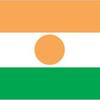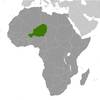Niger [+]Compare [E]dit [H]istory
Aliases: Republic of Niger, Republique du NigerObject «Niger» was created due to
Add new object to «Niger» or move existing objects here.
Object «Niger» has attributes [Show empty attributes][Hide empty attributes]
| Attribute | Value |
|---|---|
| Geography | |
| Area | 1,267,000 km² |
| Continent | Africa |
| Land area | 1,266,700 km² |
| Water area | 300 km² |
| Land boundaries | 5,834 km |
| Border countries |
|
| Coastline | 0 km |
| Mean elevation | 474 m |
| Lowest point | 200 m |
| Highest point | 2,022 m |
| People | |
| Population | 22,772,361 |
| Official languages |
|
| Religion | Muslim |
| Government | |
| Long country name | Republic of Niger |
| Short country name | Niger |
| Long local name | Republique du Niger |
| Short local name | Niger |
| Former name | Add |
| Government type | Semi-presidential republic |
| Capital | Niamey |
| Economy | |
| GDP (PPP) | 21,860,000,000 USD |
| GDP (OER) | 8,224,000,000 USD |
| GDP (real growth rate) | 4.9 % |
| GDP - per capita (PPP) | 1,200 USD |
| Gross national saving | 22.4 % of GDP |
| Labor force | 6,500,000 |
| Unemployment rate | 0.3 % |
| Population below poverty line | 45.4 % |
| Budget revenues | 1,757,000,000 USD |
| Budget expenditures | 2,171,000,000 USD |
| Military expenditures | 2.45 % of GDP |
| Taxes and other revenues | 21.4 % of GDP |
| Budget surplus or deficit | -5 % of GDP |
| Public debt | 45.3 % of GDP |
| Inflation rate | 2.4 % |
| Central bank discount rate | 4.25 % |
| Commercial bank prime lending rate | 5.4 % |
| Stock of narrow money | 1,804,000,000 USD |
| Stock of broad money | 1,804,000,000 USD |
| Stock of domestic credit | 1,506,000,000 USD |
| Market value of publicly traded shares | Add |
| Current account balance | -1,160,000,000 USD |
| Exports | 4,143,000,000 USD |
| Imports | 1,829,000,000 USD |
| Reserves of foreign exchange and gold | 1,314,000,000 USD |
| External debt | 3,728,000,000 USD |
| National currency | Communaute Financiere Africaine francs |
| National currency (code) | XOF |
| National currency (symbol) | Add |
| National currency rate to USD | 605.3 |
Niger became independent from France in 1960 and experienced single-party and military rule until 1991, when Gen. Ali SAIBOU was forced by public pressure to allow multiparty elections, which resulted in a democratic government in 1993. Political infighting brought the government to a standstill and in 1996 led to a coup by Col. Ibrahim BARE. In 1999, BARE was killed in a counter coup by military officers who restored democratic rule and held elections that brought Mamadou TANDJA to power in December of that year. TANDJA was reelected in 2004 and in 2009 spearheaded a constitutional amendment allowing him to extend his term as president. In February 2010, military officers led a coup that deposed TANDJA and suspended the constitution. ISSOUFOU Mahamadou was elected in April 2011 following the coup and reelected to a second term in early 2016. Niger is one of the poorest countries in the world with minimal government services and insufficient funds to develop its resource base, and is ranked last in the world on the United Nations Development Programme’s Human Development Index. The largely agrarian and subsistence-based economy is frequently disrupted by extended droughts common to the Sahel region of Africa. The Nigerien Government continues its attempts to diversify the economy through increased oil production and mining projects. A Tuareg rebellion emerged in 2007 and ended in 2009. Niger is facing increased security concerns on its borders from various external threats including insecurity in Libya, spillover from the conflict in Mali, and violent extremism in northeastern Nigeria.
Similar objects
Most often compared with
Everyone can something to edit or add.
There were 2 edits, no edits waiting approval. Last edited by Guest_1196(-101), May 26, 2020 (46 fields were changed)
Help · Contact us · Disclaimer · Contributors · Developers · Donate


